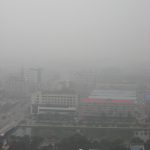Green China, pt. 1: The Rise of the Green Dragon Posted by Stephen on Nov 11, 2010 in Uncategorized
 While the debate on climate change rages on, and many western nations begin looking toward alternative forms of renewable, green energy, one thing is for sure: China is leading the green charge. You may find it interesting that one of the most polluted countries in the world is also the “greenest” in terms of renewable resources, but thats the way it goes when you try to industrialize a population of over 1 billion people in just a few decades. There are a multitude of factors and reasons why China has gravitated toward the renewable energies sector which I will detail below, but the overriding theme I’ve discovered is quite simple: China doesn’t like to waste or 浪费 (làng fèi) anything.
While the debate on climate change rages on, and many western nations begin looking toward alternative forms of renewable, green energy, one thing is for sure: China is leading the green charge. You may find it interesting that one of the most polluted countries in the world is also the “greenest” in terms of renewable resources, but thats the way it goes when you try to industrialize a population of over 1 billion people in just a few decades. There are a multitude of factors and reasons why China has gravitated toward the renewable energies sector which I will detail below, but the overriding theme I’ve discovered is quite simple: China doesn’t like to waste or 浪费 (làng fèi) anything.
On my first visit to China in 2006, I was quickly introduced to the the concept of “waste not, want not” from day one. Fancying myself an avid environmentalist throughout high school and college, I thought I had already trained myself to recycle, conserve and cut down on my green house gas emissions with great efficiency. In years prior, I studied abroad in Taiwan, but was quick to notice the prevalence of garbage and smog producing automobiles, excessive light displays and a lifestyle that seemed quite similar to that of the United States, namely, consumption driven. My thought was that I could put my environmentalist tendencies to good use in the mainland…boy was I wrong.
In the mainland, my host family monitored every energy or resource-using activity I did. I couldn’t leave my computer on when I wasn’t using it. I could only flush the toilet after a 大便 (dà biàn) or “number 2”, but was urged to leave my 小便 (xiǎo biàn) or “number 1” in the toilet (in the US we have a phrase if it’s yellow let it mellow…). Heat and AC were almost never used, unless the temperatures fell below freezing or soared above the 90’s in Fahrenheit (30 degree C) requiring me to wake up in a pool of sweat during the summer months and wear layers upon layers of thermals and long underwear, coats and even blankets when in the house during the winter. Plus we recycled everything, including mounds of lined-paper completely filled with my 汉字 (Hàn zì) or character scribbles from class. Even old clothes that had holes in them later became “mops” and “rags” by my frugal host mom.
What was most interesting about this fervent attempt at conservation were the motivations behind it. My host family wasn’t really doing it for the environment, and they were well enough off to afford the ridiculously cheap electricity and water bills that are partially subsidized by the government. They were simply doing it because anything else would be wasteful. It was both admirable and telling about the culture. It wasn’t a “green culture,” but rather a highly pragmatic one.
When I returned the next summer to Shaolin, I was quick to notice that nearly every building in Deng Feng had a solar-thermal water heater on top of it. When I returned to Beijing, green buildings touting Lead-certified architecture had sprung up everywhere. China was starting to go green for environmental reasons now. People were equating the terrible smog, sandstorms and monsoons as a product of industrialization and now they wanted to fix it. This is namely because on June 4th, 2007, China enacted its first National Action Plan on Climate Change, and became the first developing country to publish a national strategy addressing global warming. Clearly the environment was becoming a hot topic.
Then a summer later in 2008, prior to the Olympics, Beijing embarked on a multitude of policy prescriptions, including a mitigation of construction and coal/steel plants, the planting of forest corridor on the outskirts of the city (to stop the encroaching desert) and even policies of alternating between odd and even numbered license plates (called 单双) to limit air pollution caused by traffic. In just a couple of years, a concept of “Green China” had emerged and was now being articulated.
http://www.youtube.com/watch?v=qX4RTExVc_I
Fast forward to the present and what do you see? China is now both the largest producer of greenhouse gases and CO2 emissions along with the world largest producer of renewable energies or 可再生能源 (Kě zàishēng néngyuán). China is the industry leader in many renewable technologies such as wind and solar, yet has increasingly toxic water supplies and land loss. If this trend continues coupled with China’s huge work force and focus on engineering and technology accumulation, China will be the dominant the global green industry, while the domestic population chokes on the lingering effects of industrialization. China is a nation of immense problems and pragmatic solutions, the question is whether or not one can balance the other, or if the Chinese environment will reach a “tipping point”.
While I cast the future of China’s green industries quite optimistically, this does not mean that China is free from a plethora of environmental and security concerns that threaten to cripple the country in decades to come. Many economists and scientists have claimed that China’s rampant GDP growth, when weighed against the long-term negative externalities of pollution, land and water loss, put actual GDP growth as just a few points over zero, or in some situations, actually believe it has had a negative GDP effect.
To be brutally honest, China will feel the effects of the environment on its balance sheet in the years to come, as incidents of cancer will vastly increase (due to air pollution, chemicals and tainted food/water supplies), land-productivity and desertification will diminish water and food supplies, and growing demand of fossil fuel based energies will suck up supply and cause energy costs to skyrocket. Yet unlike most countries, China is actually doing something about it, and fast, creating a sustainable industry that allows for sustainable growth and development. The Green Dragon is on the rise.

Build vocabulary, practice pronunciation, and more with Transparent Language Online. Available anytime, anywhere, on any device.
About the Author: Stephen
Writer and blogger for all things China related. Follow me on twitter: @seeitbelieveit -- My Background: Fluent Mandarin speaker with 3+ years working, living, studying and teaching throughout the mainland. Student of Kung Fu and avid photographer and documentarian.






Leave a comment: